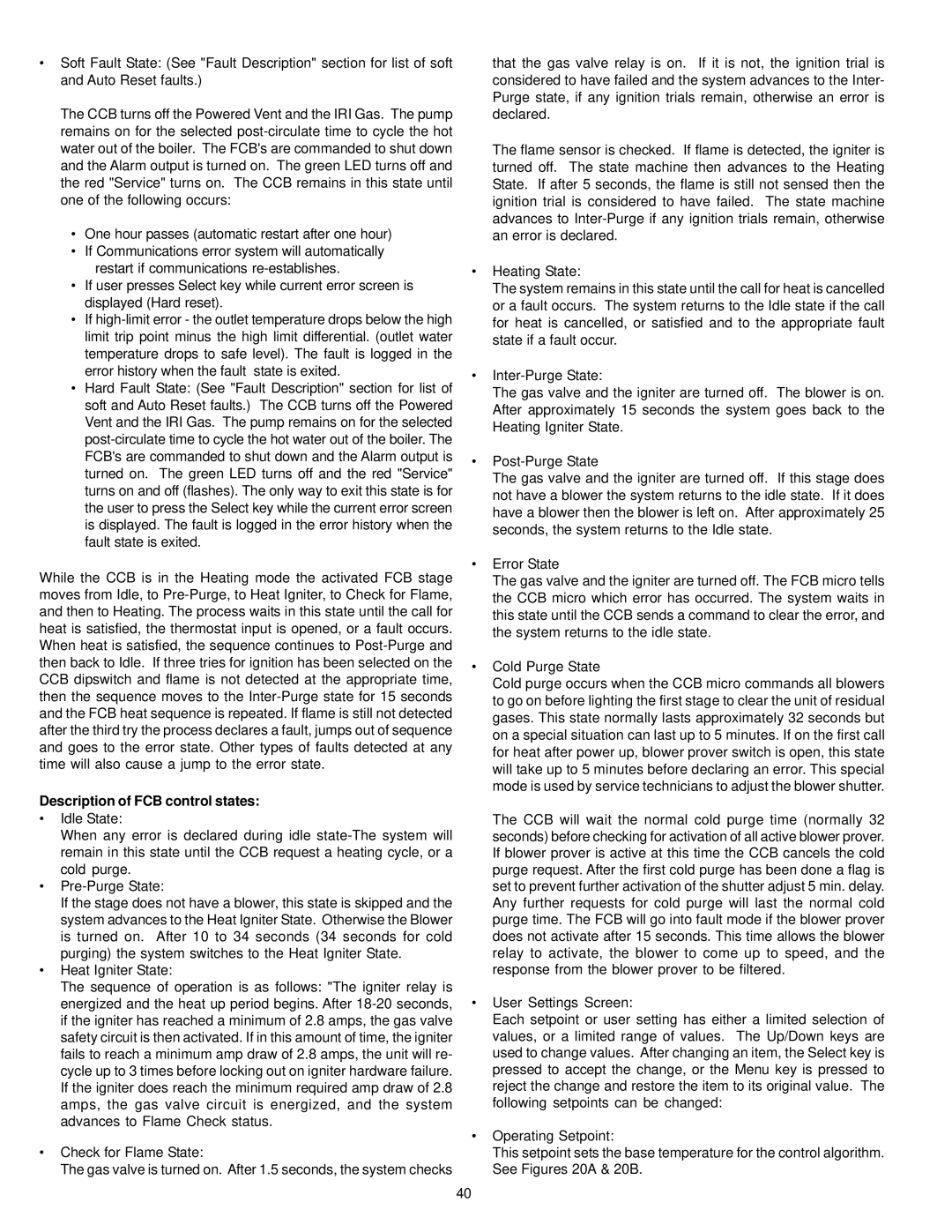•Soft Fault State: (See "Fault Description" section for list of soft and Auto Reset faults.)
The CCB turns off the Powered Vent and the IRI Gas. The pump remains on for the selected
•One hour passes (automatic restart after one hour)
•If Communications error system will automatically
restart if communications
•If user presses Select key while current error screen is displayed (Hard reset).
•If
•Hard Fault State: (See "Fault Description" section for list of soft and Auto Reset faults.) The CCB turns off the Powered Vent and the IRI Gas. The pump remains on for the selected
While the CCB is in the Heating mode the activated FCB stage moves from Idle, to
Description of FCB control states:
•Idle State:
When any error is declared during idle
•
If the stage does not have a blower, this state is skipped and the system advances to the Heat Igniter State. Otherwise the Blower is turned on. After 10 to 34 seconds (34 seconds for cold purging) the system switches to the Heat Igniter State.
•Heat Igniter State:
The sequence of operation is as follows: "The igniter relay is energized and the heat up period begins. After
•Check for Flame State:
The gas valve is turned on. After 1.5 seconds, the system checks
that the gas valve relay is on. If it is not, the ignition trial is considered to have failed and the system advances to the Inter- Purge state, if any ignition trials remain, otherwise an error is declared.
The flame sensor is checked. If flame is detected, the igniter is turned off. The state machine then advances to the Heating State. If after 5 seconds, the flame is still not sensed then the ignition trial is considered to have failed. The state machine advances to
•Heating State:
The system remains in this state until the call for heat is cancelled or a fault occurs. The system returns to the Idle state if the call for heat is cancelled, or satisfied and to the appropriate fault state if a fault occur.
•
The gas valve and the igniter are turned off. The blower is on. After approximately 15 seconds the system goes back to the Heating Igniter State.
•
The gas valve and the igniter are turned off. If this stage does not have a blower the system returns to the idle state. If it does have a blower then the blower is left on. After approximately 25 seconds, the system returns to the Idle state.
•Error State
The gas valve and the igniter are turned off. The FCB micro tells the CCB micro which error has occurred. The system waits in this state until the CCB sends a command to clear the error, and the system returns to the idle state.
•Cold Purge State
Cold purge occurs when the CCB micro commands all blowers to go on before lighting the first stage to clear the unit of residual gases. This state normally lasts approximately 32 seconds but on a special situation can last up to 5 minutes. If on the first call for heat after power up, blower prover switch is open, this state will take up to 5 minutes before declaring an error. This special mode is used by service technicians to adjust the blower shutter.
The CCB will wait the normal cold purge time (normally 32 seconds) before checking for activation of all active blower prover. If blower prover is active at this time the CCB cancels the cold purge request. After the first cold purge has been done a flag is set to prevent further activation of the shutter adjust 5 min. delay. Any further requests for cold purge will last the normal cold purge time. The FCB will go into fault mode if the blower prover does not activate after 15 seconds. This time allows the blower relay to activate, the blower to come up to speed, and the response from the blower prover to be filtered.
•User Settings Screen:
Each setpoint or user setting has either a limited selection of values, or a limited range of values. The Up/Down keys are used to change values. After changing an item, the Select key is pressed to accept the change, or the Menu key is pressed to reject the change and restore the item to its original value. The following setpoints can be changed:
•Operating Setpoint:
This setpoint sets the base temperature for the control algorithm. See Figures 20A & 20B.
40
